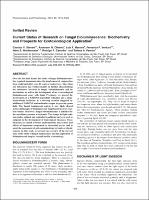Please use this identifier to cite or link to this item:
https://hdl.handle.net/20.500.12202/9611Full metadata record
| DC Field | Value | Language |
|---|---|---|
| dc.contributor.author | Stevani, Cassius V. | - |
| dc.contributor.author | Oliveira, Anderson G. | - |
| dc.contributor.author | Mendes, Luiz F. | - |
| dc.contributor.author | Ventura, Fernanda F. | - |
| dc.contributor.author | Waldenmaier, Hans E. | - |
| dc.contributor.author | Carvalho, Rodrigo P. | - |
| dc.contributor.author | Pereira, Tatiana A. | - |
| dc.date.accessioned | 2023-12-07T22:10:11Z | - |
| dc.date.available | 2023-12-07T22:10:11Z | - |
| dc.date.issued | 2013-11 | - |
| dc.identifier.citation | Stevani, C. V., Oliveira, A. G., Mendes, L. F., Ventura, F. F., Waldenmaier, H. E., Carvalho, R. P., & Pereira, T. A. (2013). Current Status of Research on Fungal Bioluminescence: Biochemistry and Prospects for Ecotoxicological Application. Photochemistry and Photobiology, 89(6), 1318. | en_US |
| dc.identifier.issn | 0031-8655 | - |
| dc.identifier.uri | https://hdl.handle.net/20.500.12202/9611 | - |
| dc.description | Scholarly article / Open access | en_US |
| dc.description.abstract | Over the last half decade the study of fungal bioluminescence has regained momentum since the involvement of enzymes has been confirmed after over 40 years of controversy. Since then our laboratory has worked mainly on further characterizing the substances involved in fungal bioluminescence and its mechanism, as well as the development of an ecotoxicological bioluminescent assay with fungi. Previously, we proved the involvement of a NAD(P)H-dependent reductase and a membrane-bound luciferase in a two-step reaction triggered by addition of NAD(P)H and molecular oxygen to generate green light. The fungal luminescent system is also likely shared across all lineages of bioluminescent fungi based on cross-reaction studies. Moreover, fungal bioluminescence is inhibited by the mycelium exposure to toxicants. The change in light emission under optimal and controlled conditions has been used as endpoint in the development of toxicological bioassays. These bioassays are useful to better understand the interactions and effects of hazardous compounds to terrestrial species and to assist the assessment of soil contaminations by biotic or abiotic sources. In this work, we present an overview of the current state of the study of fungal luminescence and the application of bioluminescent fungi as versatile tool in ecotoxicology. Article Note: This article is part of the Special Issue dedicated to the memory of Elsa Abuin. | en_US |
| dc.description.sponsorship | Acknowledgements—We are indebted to the Instituto Florestal for grantingus permission to collect fruiting bodies in the Parque Estadual Turístico doAlto Ribeira (PETAR) and to Dr. Ismael Dantas, owner of Cana BravaFarm in Altos, PI, Brazil, for the collection ofN. gardneri. Financialsupport was provided by the Fundacß~ao de Amparo a Pesquisa do Estado deS~ao Paulo (FAPESP) under grant numbers 10/15047-4, 06/53628-3, 04/13856-1, 09/54718-4, and 01/04753-6, NAP-PhotoTech (the USP ResearchConsortium for Photochemical Technology) to Stevani, and CAPES/CNPq | en_US |
| dc.language.iso | en_US | en_US |
| dc.publisher | Wiley | en_US |
| dc.relation.ispartofseries | Photochemistry and Photobiology;89(6) | - |
| dc.rights | Attribution-NonCommercial-NoDerivs 3.0 United States | * |
| dc.rights.uri | http://creativecommons.org/licenses/by-nc-nd/3.0/us/ | * |
| dc.subject | Biochemistry | en_US |
| dc.subject | Environmental toxicology | en_US |
| dc.subject | Luciferase | en_US |
| dc.title | Current status of research on fungal bioluminescence: biochemistry and prospects for ecotoxicological application | en_US |
| dc.type | Article | en_US |
| dc.identifier.doi | https://doi-org.ezproxy.yu.edu/10.1111/php.12135 | en_US |
| dc.contributor.orcid | 0000-0003-1752-0726 | en_US |
| local.yu.facultypage | https://www.yu.edu/faculty/pages/oliveira-anderson | en_US |
| Appears in Collections: | Stern College for Women -- Faculty Publications | |
Files in This Item:
| File | Description | Size | Format | |
|---|---|---|---|---|
| Oliveira 2013 OA Current Status of Research.pdf | 466.18 kB | Adobe PDF |  View/Open |
This item is licensed under a Creative Commons License

